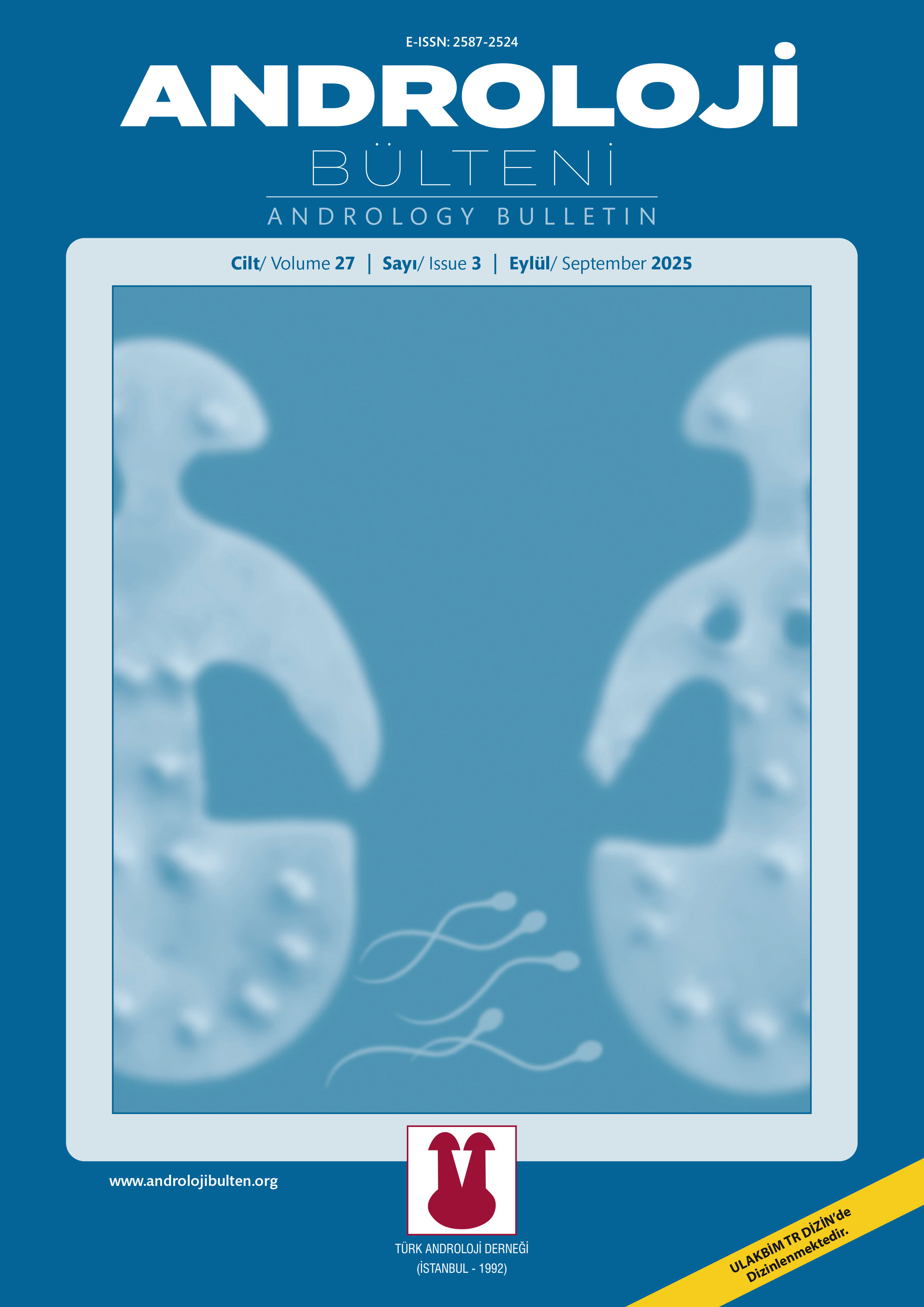
Content of this journal is licensed under a Creative Commons Attribution-NonCommercial 4.0 International License.
Evaluation of the association between acquired premature ejaculation and metabolic syndrome: A prospective, controlled study
Arzu Ateş1, Çağatay Özsoy2, Ayça Tuzcu3, Arif Kol21Nazilli State Hospital, Department of Medical Biochemistry, Aydin, Türkiye2Aydin Adnan Menderes Universtiy, School of Medicine, Department of Urology, Aydin, Türkiye
3Aydin Adnan Menderes Universtiy, School of Medicine, Department of Medical Biochemistry, Aydin, Türkiye
OBJECTIVE: The aim of this study was to investigate the relationship between metabolic syndrome (MetS) and acquired premature ejaculation (PE).
MATRERIAL and METHODS: A total of 50 patients with acquired PE and 50 control cases were enrolled in the study. After obtaining a detailed medical history, anthropometric (weight, height and waist circumference) and blood pressure measurements were performed. Ejaculation and erection functions were evaluated by Premature Ejaculation Diagnostic Tool (PEDT) and International Index of Erectile Function-5 (IIEF-5), respectively. Self-estimated intravaginal ejaculatory latency time (IELT) of the participants was recorded. Fasting blood samples were taken for biochemical and hormonal work-up.
RESULTS: The median PEDT scores were 15 (9–20) and 4 (0–8) in acquired PE and control groups, respectively (p<0.001). The mean estimated IELT values in PE patients and controls were 50,76 ± 11,19 versus 506,08 ± 49,47 s (p<0.001). MetS was diagnosed in 20 patients (40%) in the PE group and 6 (12%) participants in the control group (p=0.001). A significant negative correlation was observed between the components of MetS and estimated IELT, except for systolic blood pressure. Moreover, there was a significant positive correlation between the all components of MetS and total PEDT score. Logistic regression analysis revealed that MetS components were significant risk factors for PE.
CONCLUSION: MetS is associated with acquired PE.
Keywords: acquired premature ejaculation, metabolic syndrome, risk factor
Edinsel prematür ejakülasyon ile metabolik sendrom arasındaki ilişkinin değerlendirilmesi: Prospektif, kontrollü bir çalışma
Arzu Ateş1, Çağatay Özsoy2, Ayça Tuzcu3, Arif Kol21T.C. Sağlık Bakanlığı Nazilli Devlet Hastanesi, Tıbbi Biyokimya Departmanı, Nazilli/ Aydın, Türkiye2Aydın Adnan Menderes Üniverstiesi, Tıp Fakültesi, Üroloji Anabilim Dalı, Aydın, Türkiye
3Aydın Adnan Menderes Üniversitesi, Tıp Fakültesi, Tıbbi Biyokimya Anabilim Dalı, Aydın, Türkiye
AMAÇ: Metabolik sendrom (MetS) ile edinsel prematür ejakülasyon (PE) arasındaki ilişkiyi araştırmaktır.
GEREÇ ve YÖNTEMLER: Çalışmaya edinsel PE'li 50 hasta ve 50 kontrol vakası dahil edildi. Ayrıntılı tıbbi öykü alındıktan sonra antropometrik (kilo, boy ve bel çevresi) ve kan basıncı ölçümleri yapıldı. Ejakülasyon ve ereksiyon fonksiyonları sırasıyla Prematür Ejakülasyon Tanı Aracı (PEDT) ve Uluslararası Ereksiyon Fonksiyonu İndeksi-5 (IIEF-5) ile değerlendirildi. Katılımcıların kendi kendine tahmin edilen intravajinal ejakülasyon gecikme süresi (IELT) kaydedildi. Biyokimyasal ve hormonal çalışmalar için açlık kan örnekleri alındı.
BULGULAR: Edinsel PE ve kontrol gruplarında ortanca PEDT skorları sırasıyla 15 (9-20) ve 4 (0-8) idi (p<0.001). PE hastalarında ve kontrollerde tahmini ortalama IELT değerleri 50,76 ± 11,19 karşı 506,08 ± 49,47 saniyeydi (p<0,001). PE grubunda 20 hastada (%40) ve kontrol grubunda 6 katılımcıda (%12) MetS tanısı kondu (p=0,001). Sistolik kan basıncı hariç MetS bileşenleri ile tahmini IELT arasında anlamlı negatif korelasyon gözlendi. Ayrıca, MetS'nin tüm bileşenleri ile toplam PEDT puanı arasında anlamlı pozitif korelasyon vardı. Lojistik regresyon analizi MetS’un tüm bileşenlerinin PE için anlamlı risk faktörleri olduğunu ortaya koydu.
SONUÇ: MetS edinilmiş PE ile ilişkilidir.
Anahtar Kelimeler: edinsel prematür ejakülasyon, metabolik sendrom, risk faktör
Manuscript Language: Turkish
(183 downloaded)













